Economics Assignment: Government Intervention in Open Market Economy
VerifiedAdded on 2021/04/17
|10
|2654
|462
Report
AI Summary
This economics assignment delves into the ongoing debate surrounding government intervention in open market economies, focusing on the use of price ceilings and price floors as tools to manage market failures. The report critically analyzes the theoretical underpinnings of these policies, examining their potential benefits and drawbacks, including impacts on consumer and producer surplus, as well as the potential for creating market inefficiencies. A significant portion of the assignment is dedicated to examining the Australian government's minimum wage policy, treating it as a form of price ceiling and assessing its effects on employment, wage rates, and the overall labor market. The analysis incorporates diverse perspectives on the minimum wage's impact, drawing from various research studies. The assignment concludes with recommendations for policymakers, advocating for a nuanced approach to government intervention that considers regional variations and the specific needs of different sectors, while also promoting skill development initiatives to address potential labor market imbalances. The report emphasizes the importance of balancing market stability with the potential for economic growth and efficiency.
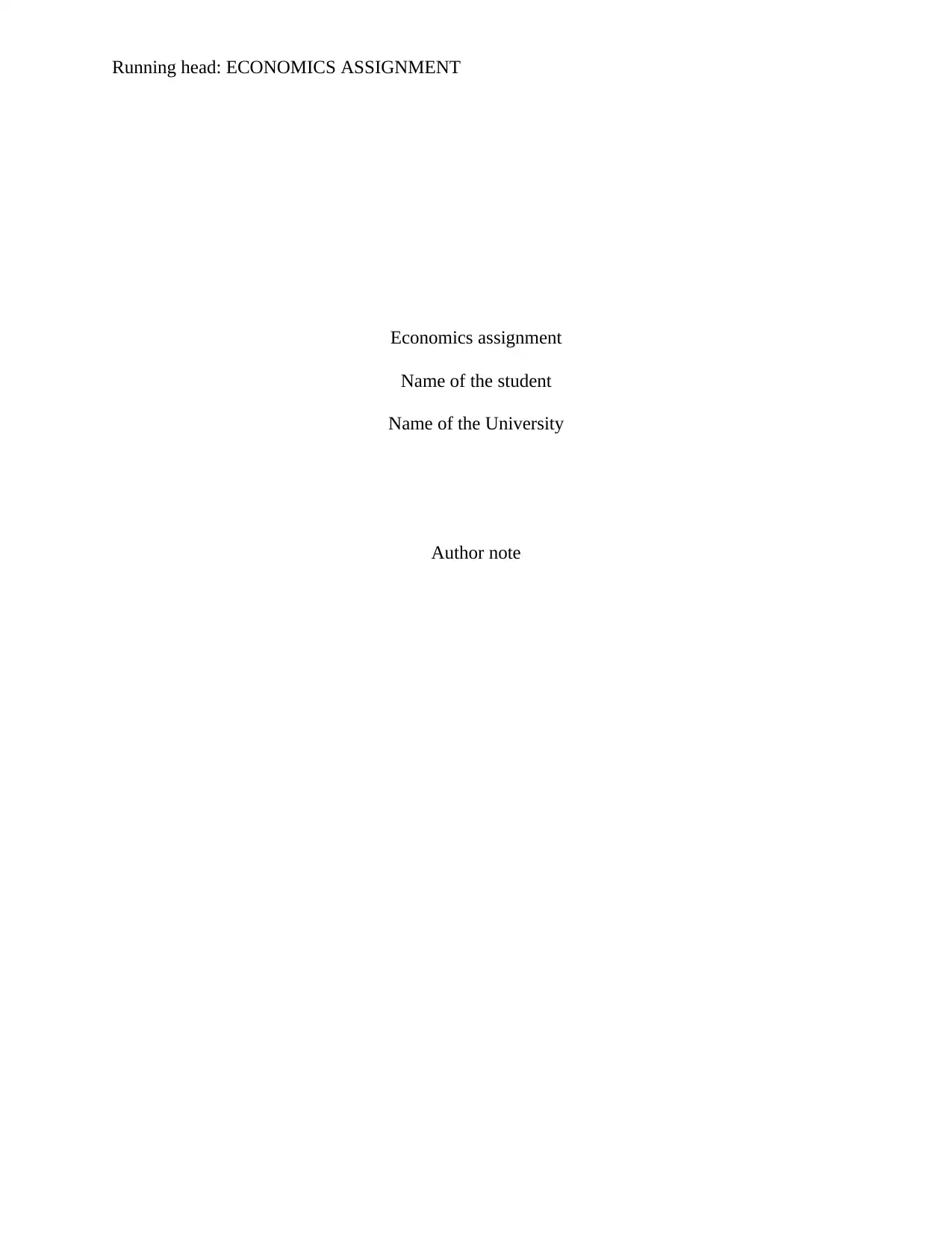
Running head: ECONOMICS ASSIGNMENT
Economics assignment
Name of the student
Name of the University
Author note
Economics assignment
Name of the student
Name of the University
Author note
Paraphrase This Document
Need a fresh take? Get an instant paraphrase of this document with our AI Paraphraser
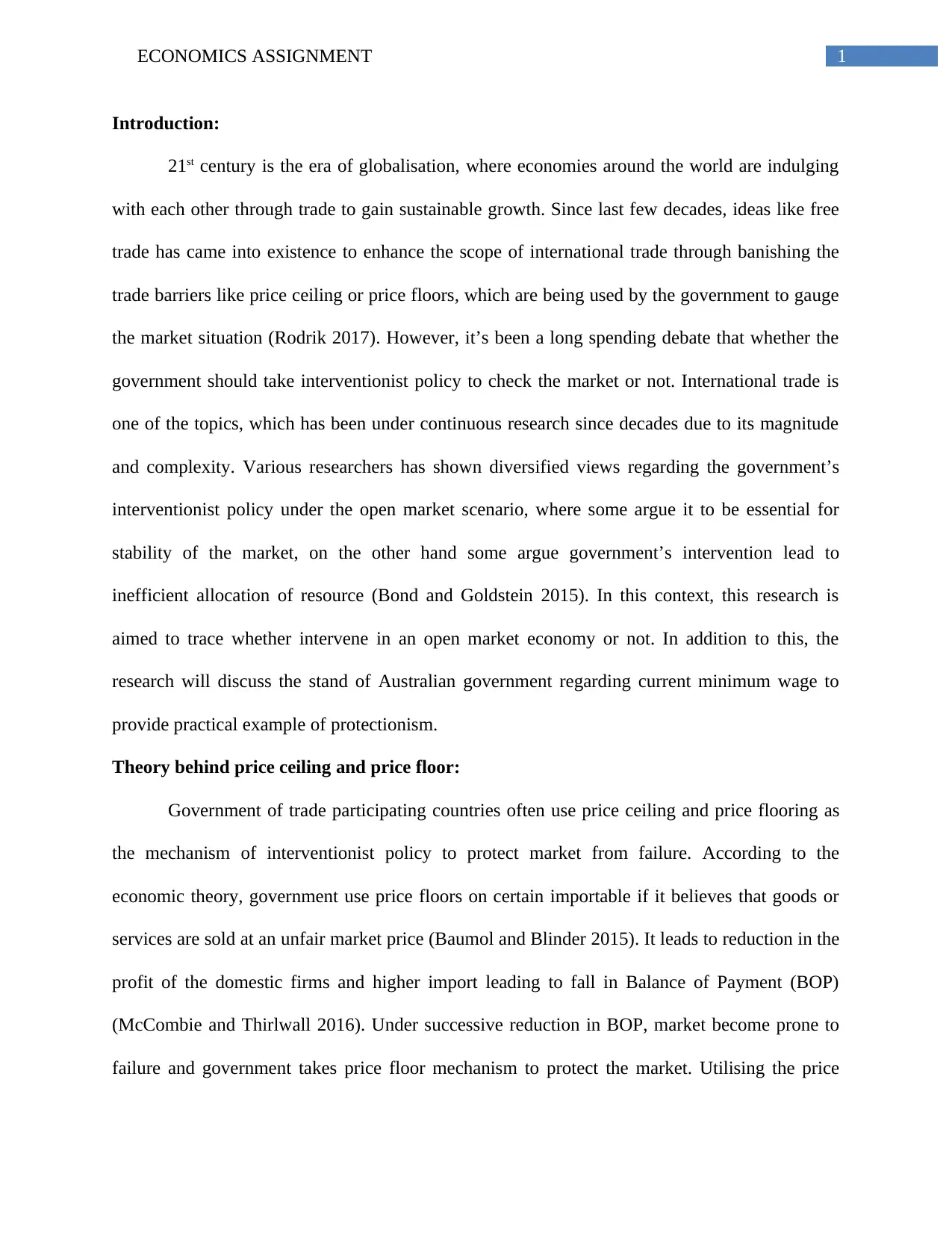
1ECONOMICS ASSIGNMENT
Introduction:
21st century is the era of globalisation, where economies around the world are indulging
with each other through trade to gain sustainable growth. Since last few decades, ideas like free
trade has came into existence to enhance the scope of international trade through banishing the
trade barriers like price ceiling or price floors, which are being used by the government to gauge
the market situation (Rodrik 2017). However, it’s been a long spending debate that whether the
government should take interventionist policy to check the market or not. International trade is
one of the topics, which has been under continuous research since decades due to its magnitude
and complexity. Various researchers has shown diversified views regarding the government’s
interventionist policy under the open market scenario, where some argue it to be essential for
stability of the market, on the other hand some argue government’s intervention lead to
inefficient allocation of resource (Bond and Goldstein 2015). In this context, this research is
aimed to trace whether intervene in an open market economy or not. In addition to this, the
research will discuss the stand of Australian government regarding current minimum wage to
provide practical example of protectionism.
Theory behind price ceiling and price floor:
Government of trade participating countries often use price ceiling and price flooring as
the mechanism of interventionist policy to protect market from failure. According to the
economic theory, government use price floors on certain importable if it believes that goods or
services are sold at an unfair market price (Baumol and Blinder 2015). It leads to reduction in the
profit of the domestic firms and higher import leading to fall in Balance of Payment (BOP)
(McCombie and Thirlwall 2016). Under successive reduction in BOP, market become prone to
failure and government takes price floor mechanism to protect the market. Utilising the price
Introduction:
21st century is the era of globalisation, where economies around the world are indulging
with each other through trade to gain sustainable growth. Since last few decades, ideas like free
trade has came into existence to enhance the scope of international trade through banishing the
trade barriers like price ceiling or price floors, which are being used by the government to gauge
the market situation (Rodrik 2017). However, it’s been a long spending debate that whether the
government should take interventionist policy to check the market or not. International trade is
one of the topics, which has been under continuous research since decades due to its magnitude
and complexity. Various researchers has shown diversified views regarding the government’s
interventionist policy under the open market scenario, where some argue it to be essential for
stability of the market, on the other hand some argue government’s intervention lead to
inefficient allocation of resource (Bond and Goldstein 2015). In this context, this research is
aimed to trace whether intervene in an open market economy or not. In addition to this, the
research will discuss the stand of Australian government regarding current minimum wage to
provide practical example of protectionism.
Theory behind price ceiling and price floor:
Government of trade participating countries often use price ceiling and price flooring as
the mechanism of interventionist policy to protect market from failure. According to the
economic theory, government use price floors on certain importable if it believes that goods or
services are sold at an unfair market price (Baumol and Blinder 2015). It leads to reduction in the
profit of the domestic firms and higher import leading to fall in Balance of Payment (BOP)
(McCombie and Thirlwall 2016). Under successive reduction in BOP, market become prone to
failure and government takes price floor mechanism to protect the market. Utilising the price
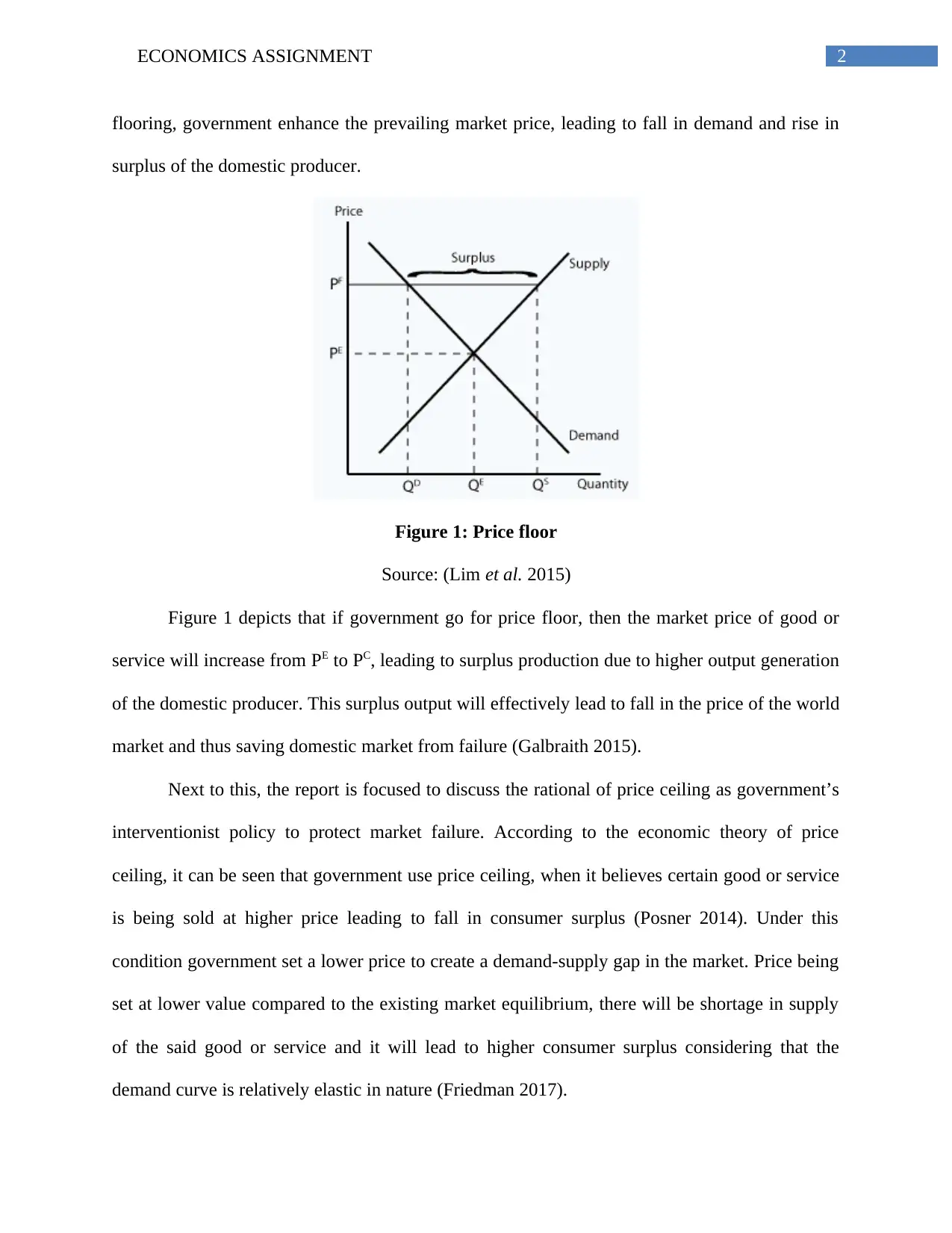
2ECONOMICS ASSIGNMENT
flooring, government enhance the prevailing market price, leading to fall in demand and rise in
surplus of the domestic producer.
Figure 1: Price floor
Source: (Lim et al. 2015)
Figure 1 depicts that if government go for price floor, then the market price of good or
service will increase from PE to PC, leading to surplus production due to higher output generation
of the domestic producer. This surplus output will effectively lead to fall in the price of the world
market and thus saving domestic market from failure (Galbraith 2015).
Next to this, the report is focused to discuss the rational of price ceiling as government’s
interventionist policy to protect market failure. According to the economic theory of price
ceiling, it can be seen that government use price ceiling, when it believes certain good or service
is being sold at higher price leading to fall in consumer surplus (Posner 2014). Under this
condition government set a lower price to create a demand-supply gap in the market. Price being
set at lower value compared to the existing market equilibrium, there will be shortage in supply
of the said good or service and it will lead to higher consumer surplus considering that the
demand curve is relatively elastic in nature (Friedman 2017).
flooring, government enhance the prevailing market price, leading to fall in demand and rise in
surplus of the domestic producer.
Figure 1: Price floor
Source: (Lim et al. 2015)
Figure 1 depicts that if government go for price floor, then the market price of good or
service will increase from PE to PC, leading to surplus production due to higher output generation
of the domestic producer. This surplus output will effectively lead to fall in the price of the world
market and thus saving domestic market from failure (Galbraith 2015).
Next to this, the report is focused to discuss the rational of price ceiling as government’s
interventionist policy to protect market failure. According to the economic theory of price
ceiling, it can be seen that government use price ceiling, when it believes certain good or service
is being sold at higher price leading to fall in consumer surplus (Posner 2014). Under this
condition government set a lower price to create a demand-supply gap in the market. Price being
set at lower value compared to the existing market equilibrium, there will be shortage in supply
of the said good or service and it will lead to higher consumer surplus considering that the
demand curve is relatively elastic in nature (Friedman 2017).
⊘ This is a preview!⊘
Do you want full access?
Subscribe today to unlock all pages.

Trusted by 1+ million students worldwide
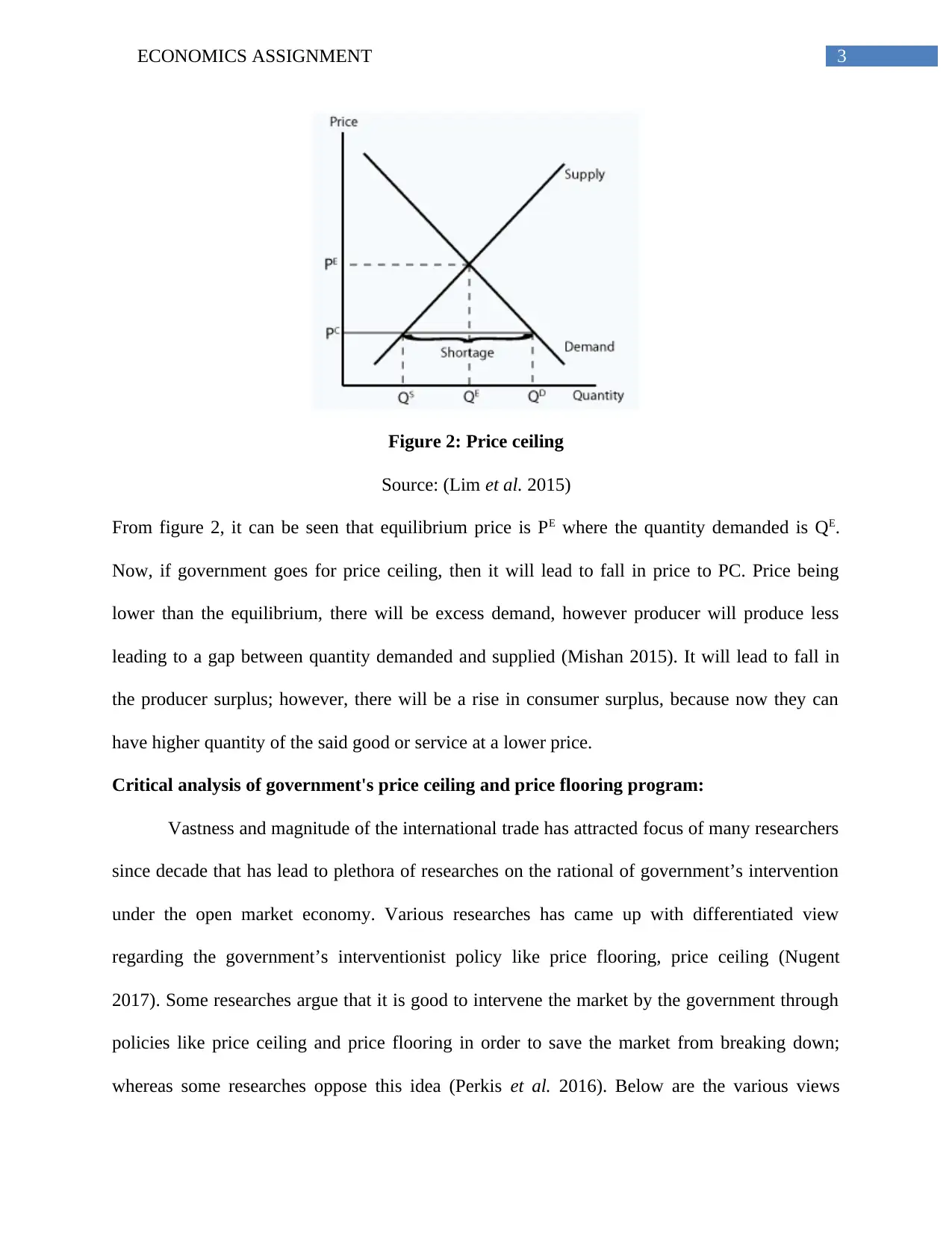
3ECONOMICS ASSIGNMENT
Figure 2: Price ceiling
Source: (Lim et al. 2015)
From figure 2, it can be seen that equilibrium price is PE where the quantity demanded is QE.
Now, if government goes for price ceiling, then it will lead to fall in price to PC. Price being
lower than the equilibrium, there will be excess demand, however producer will produce less
leading to a gap between quantity demanded and supplied (Mishan 2015). It will lead to fall in
the producer surplus; however, there will be a rise in consumer surplus, because now they can
have higher quantity of the said good or service at a lower price.
Critical analysis of government's price ceiling and price flooring program:
Vastness and magnitude of the international trade has attracted focus of many researchers
since decade that has lead to plethora of researches on the rational of government’s intervention
under the open market economy. Various researches has came up with differentiated view
regarding the government’s interventionist policy like price flooring, price ceiling (Nugent
2017). Some researches argue that it is good to intervene the market by the government through
policies like price ceiling and price flooring in order to save the market from breaking down;
whereas some researches oppose this idea (Perkis et al. 2016). Below are the various views
Figure 2: Price ceiling
Source: (Lim et al. 2015)
From figure 2, it can be seen that equilibrium price is PE where the quantity demanded is QE.
Now, if government goes for price ceiling, then it will lead to fall in price to PC. Price being
lower than the equilibrium, there will be excess demand, however producer will produce less
leading to a gap between quantity demanded and supplied (Mishan 2015). It will lead to fall in
the producer surplus; however, there will be a rise in consumer surplus, because now they can
have higher quantity of the said good or service at a lower price.
Critical analysis of government's price ceiling and price flooring program:
Vastness and magnitude of the international trade has attracted focus of many researchers
since decade that has lead to plethora of researches on the rational of government’s intervention
under the open market economy. Various researches has came up with differentiated view
regarding the government’s interventionist policy like price flooring, price ceiling (Nugent
2017). Some researches argue that it is good to intervene the market by the government through
policies like price ceiling and price flooring in order to save the market from breaking down;
whereas some researches oppose this idea (Perkis et al. 2016). Below are the various views
Paraphrase This Document
Need a fresh take? Get an instant paraphrase of this document with our AI Paraphraser
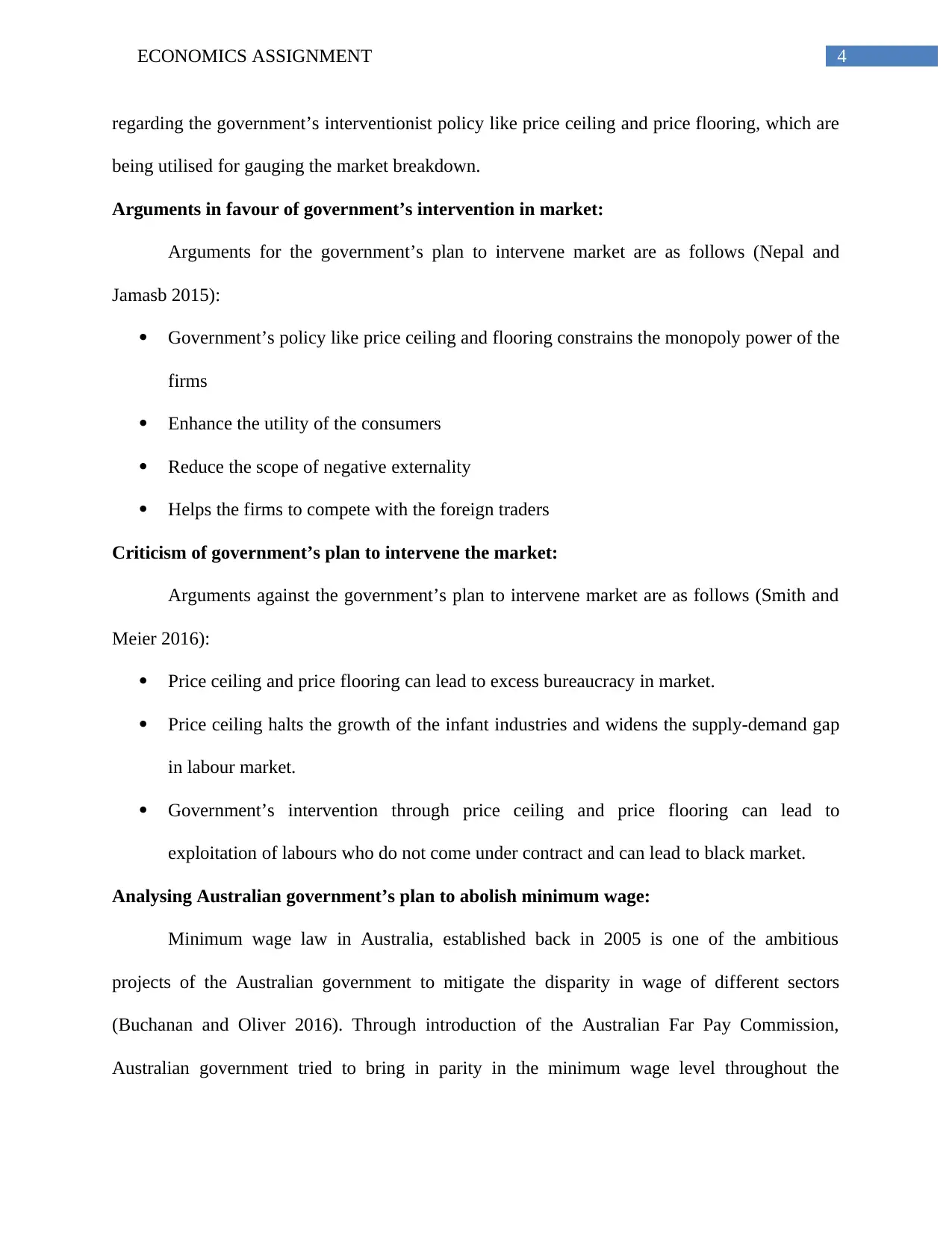
4ECONOMICS ASSIGNMENT
regarding the government’s interventionist policy like price ceiling and price flooring, which are
being utilised for gauging the market breakdown.
Arguments in favour of government’s intervention in market:
Arguments for the government’s plan to intervene market are as follows (Nepal and
Jamasb 2015):
Government’s policy like price ceiling and flooring constrains the monopoly power of the
firms
Enhance the utility of the consumers
Reduce the scope of negative externality
Helps the firms to compete with the foreign traders
Criticism of government’s plan to intervene the market:
Arguments against the government’s plan to intervene market are as follows (Smith and
Meier 2016):
Price ceiling and price flooring can lead to excess bureaucracy in market.
Price ceiling halts the growth of the infant industries and widens the supply-demand gap
in labour market.
Government’s intervention through price ceiling and price flooring can lead to
exploitation of labours who do not come under contract and can lead to black market.
Analysing Australian government’s plan to abolish minimum wage:
Minimum wage law in Australia, established back in 2005 is one of the ambitious
projects of the Australian government to mitigate the disparity in wage of different sectors
(Buchanan and Oliver 2016). Through introduction of the Australian Far Pay Commission,
Australian government tried to bring in parity in the minimum wage level throughout the
regarding the government’s interventionist policy like price ceiling and price flooring, which are
being utilised for gauging the market breakdown.
Arguments in favour of government’s intervention in market:
Arguments for the government’s plan to intervene market are as follows (Nepal and
Jamasb 2015):
Government’s policy like price ceiling and flooring constrains the monopoly power of the
firms
Enhance the utility of the consumers
Reduce the scope of negative externality
Helps the firms to compete with the foreign traders
Criticism of government’s plan to intervene the market:
Arguments against the government’s plan to intervene market are as follows (Smith and
Meier 2016):
Price ceiling and price flooring can lead to excess bureaucracy in market.
Price ceiling halts the growth of the infant industries and widens the supply-demand gap
in labour market.
Government’s intervention through price ceiling and price flooring can lead to
exploitation of labours who do not come under contract and can lead to black market.
Analysing Australian government’s plan to abolish minimum wage:
Minimum wage law in Australia, established back in 2005 is one of the ambitious
projects of the Australian government to mitigate the disparity in wage of different sectors
(Buchanan and Oliver 2016). Through introduction of the Australian Far Pay Commission,
Australian government tried to bring in parity in the minimum wage level throughout the
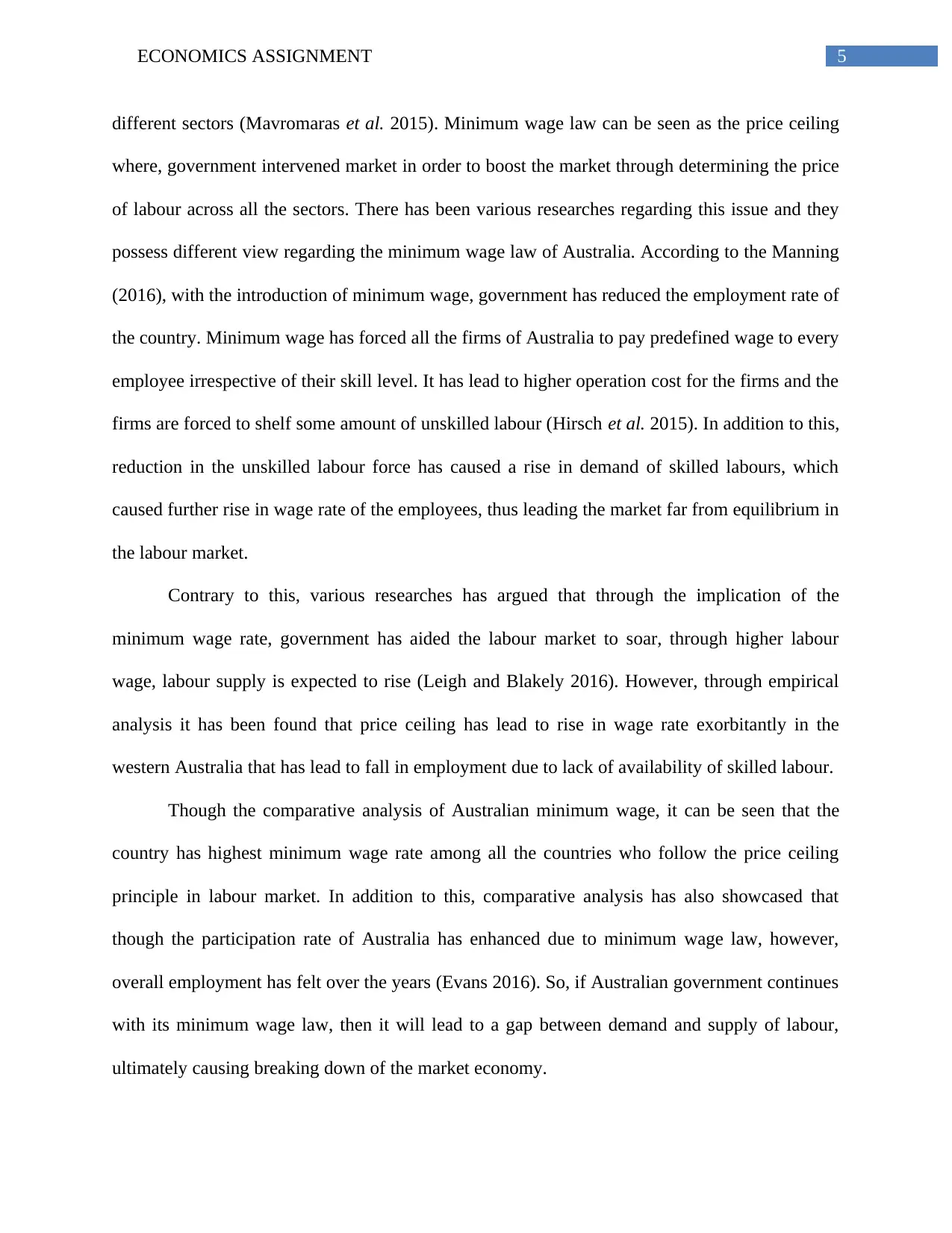
5ECONOMICS ASSIGNMENT
different sectors (Mavromaras et al. 2015). Minimum wage law can be seen as the price ceiling
where, government intervened market in order to boost the market through determining the price
of labour across all the sectors. There has been various researches regarding this issue and they
possess different view regarding the minimum wage law of Australia. According to the Manning
(2016), with the introduction of minimum wage, government has reduced the employment rate of
the country. Minimum wage has forced all the firms of Australia to pay predefined wage to every
employee irrespective of their skill level. It has lead to higher operation cost for the firms and the
firms are forced to shelf some amount of unskilled labour (Hirsch et al. 2015). In addition to this,
reduction in the unskilled labour force has caused a rise in demand of skilled labours, which
caused further rise in wage rate of the employees, thus leading the market far from equilibrium in
the labour market.
Contrary to this, various researches has argued that through the implication of the
minimum wage rate, government has aided the labour market to soar, through higher labour
wage, labour supply is expected to rise (Leigh and Blakely 2016). However, through empirical
analysis it has been found that price ceiling has lead to rise in wage rate exorbitantly in the
western Australia that has lead to fall in employment due to lack of availability of skilled labour.
Though the comparative analysis of Australian minimum wage, it can be seen that the
country has highest minimum wage rate among all the countries who follow the price ceiling
principle in labour market. In addition to this, comparative analysis has also showcased that
though the participation rate of Australia has enhanced due to minimum wage law, however,
overall employment has felt over the years (Evans 2016). So, if Australian government continues
with its minimum wage law, then it will lead to a gap between demand and supply of labour,
ultimately causing breaking down of the market economy.
different sectors (Mavromaras et al. 2015). Minimum wage law can be seen as the price ceiling
where, government intervened market in order to boost the market through determining the price
of labour across all the sectors. There has been various researches regarding this issue and they
possess different view regarding the minimum wage law of Australia. According to the Manning
(2016), with the introduction of minimum wage, government has reduced the employment rate of
the country. Minimum wage has forced all the firms of Australia to pay predefined wage to every
employee irrespective of their skill level. It has lead to higher operation cost for the firms and the
firms are forced to shelf some amount of unskilled labour (Hirsch et al. 2015). In addition to this,
reduction in the unskilled labour force has caused a rise in demand of skilled labours, which
caused further rise in wage rate of the employees, thus leading the market far from equilibrium in
the labour market.
Contrary to this, various researches has argued that through the implication of the
minimum wage rate, government has aided the labour market to soar, through higher labour
wage, labour supply is expected to rise (Leigh and Blakely 2016). However, through empirical
analysis it has been found that price ceiling has lead to rise in wage rate exorbitantly in the
western Australia that has lead to fall in employment due to lack of availability of skilled labour.
Though the comparative analysis of Australian minimum wage, it can be seen that the
country has highest minimum wage rate among all the countries who follow the price ceiling
principle in labour market. In addition to this, comparative analysis has also showcased that
though the participation rate of Australia has enhanced due to minimum wage law, however,
overall employment has felt over the years (Evans 2016). So, if Australian government continues
with its minimum wage law, then it will lead to a gap between demand and supply of labour,
ultimately causing breaking down of the market economy.
⊘ This is a preview!⊘
Do you want full access?
Subscribe today to unlock all pages.

Trusted by 1+ million students worldwide
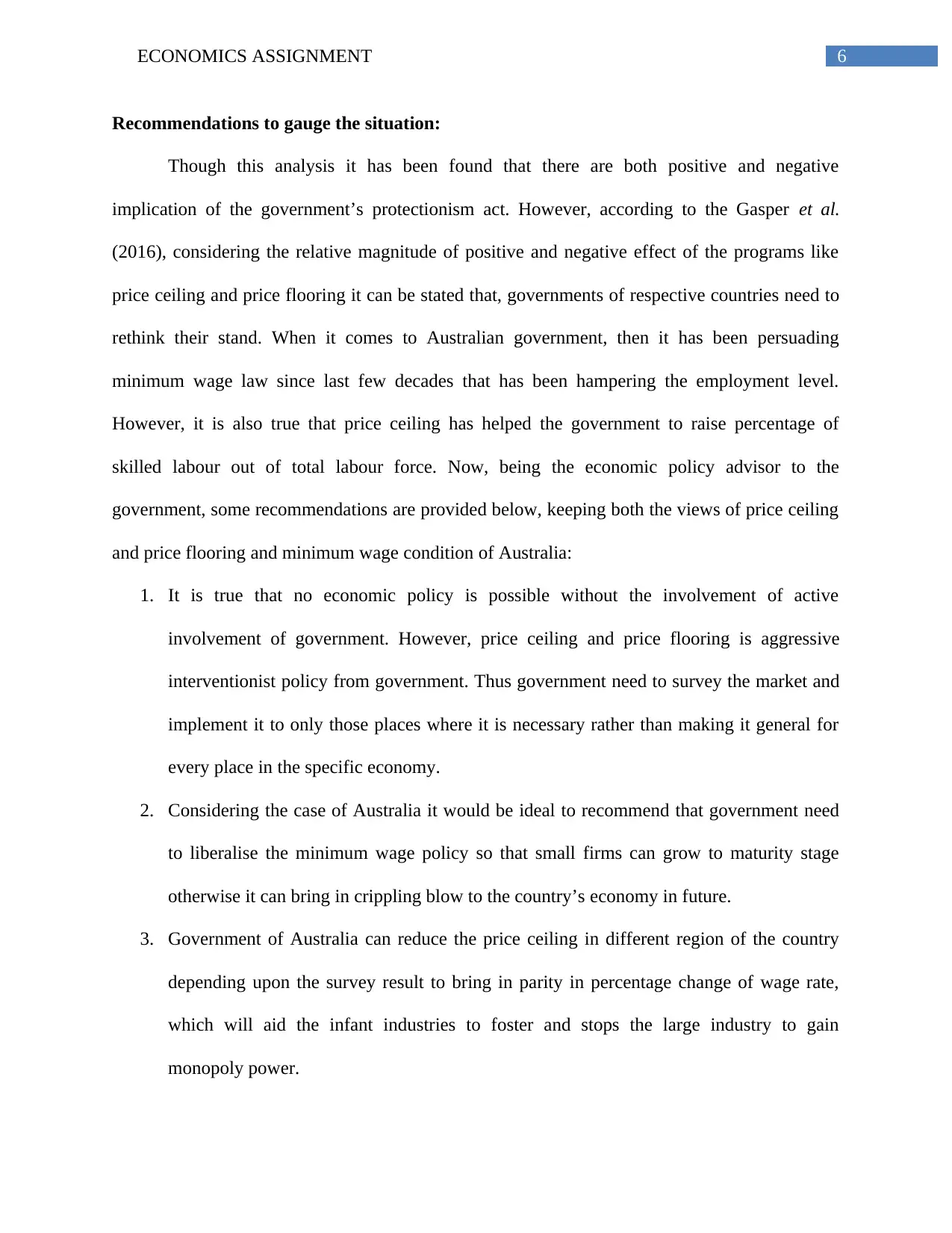
6ECONOMICS ASSIGNMENT
Recommendations to gauge the situation:
Though this analysis it has been found that there are both positive and negative
implication of the government’s protectionism act. However, according to the Gasper et al.
(2016), considering the relative magnitude of positive and negative effect of the programs like
price ceiling and price flooring it can be stated that, governments of respective countries need to
rethink their stand. When it comes to Australian government, then it has been persuading
minimum wage law since last few decades that has been hampering the employment level.
However, it is also true that price ceiling has helped the government to raise percentage of
skilled labour out of total labour force. Now, being the economic policy advisor to the
government, some recommendations are provided below, keeping both the views of price ceiling
and price flooring and minimum wage condition of Australia:
1. It is true that no economic policy is possible without the involvement of active
involvement of government. However, price ceiling and price flooring is aggressive
interventionist policy from government. Thus government need to survey the market and
implement it to only those places where it is necessary rather than making it general for
every place in the specific economy.
2. Considering the case of Australia it would be ideal to recommend that government need
to liberalise the minimum wage policy so that small firms can grow to maturity stage
otherwise it can bring in crippling blow to the country’s economy in future.
3. Government of Australia can reduce the price ceiling in different region of the country
depending upon the survey result to bring in parity in percentage change of wage rate,
which will aid the infant industries to foster and stops the large industry to gain
monopoly power.
Recommendations to gauge the situation:
Though this analysis it has been found that there are both positive and negative
implication of the government’s protectionism act. However, according to the Gasper et al.
(2016), considering the relative magnitude of positive and negative effect of the programs like
price ceiling and price flooring it can be stated that, governments of respective countries need to
rethink their stand. When it comes to Australian government, then it has been persuading
minimum wage law since last few decades that has been hampering the employment level.
However, it is also true that price ceiling has helped the government to raise percentage of
skilled labour out of total labour force. Now, being the economic policy advisor to the
government, some recommendations are provided below, keeping both the views of price ceiling
and price flooring and minimum wage condition of Australia:
1. It is true that no economic policy is possible without the involvement of active
involvement of government. However, price ceiling and price flooring is aggressive
interventionist policy from government. Thus government need to survey the market and
implement it to only those places where it is necessary rather than making it general for
every place in the specific economy.
2. Considering the case of Australia it would be ideal to recommend that government need
to liberalise the minimum wage policy so that small firms can grow to maturity stage
otherwise it can bring in crippling blow to the country’s economy in future.
3. Government of Australia can reduce the price ceiling in different region of the country
depending upon the survey result to bring in parity in percentage change of wage rate,
which will aid the infant industries to foster and stops the large industry to gain
monopoly power.
Paraphrase This Document
Need a fresh take? Get an instant paraphrase of this document with our AI Paraphraser
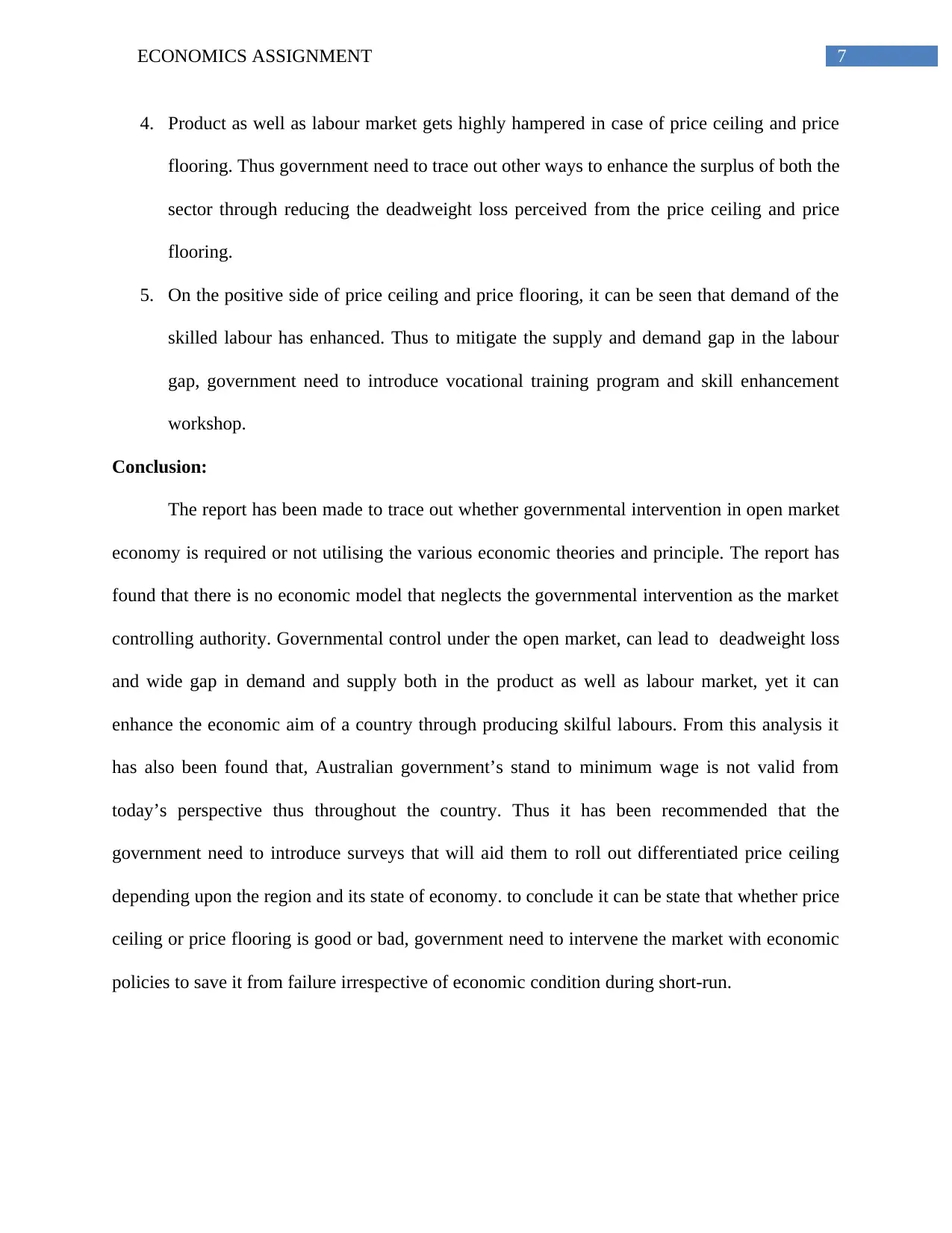
7ECONOMICS ASSIGNMENT
4. Product as well as labour market gets highly hampered in case of price ceiling and price
flooring. Thus government need to trace out other ways to enhance the surplus of both the
sector through reducing the deadweight loss perceived from the price ceiling and price
flooring.
5. On the positive side of price ceiling and price flooring, it can be seen that demand of the
skilled labour has enhanced. Thus to mitigate the supply and demand gap in the labour
gap, government need to introduce vocational training program and skill enhancement
workshop.
Conclusion:
The report has been made to trace out whether governmental intervention in open market
economy is required or not utilising the various economic theories and principle. The report has
found that there is no economic model that neglects the governmental intervention as the market
controlling authority. Governmental control under the open market, can lead to deadweight loss
and wide gap in demand and supply both in the product as well as labour market, yet it can
enhance the economic aim of a country through producing skilful labours. From this analysis it
has also been found that, Australian government’s stand to minimum wage is not valid from
today’s perspective thus throughout the country. Thus it has been recommended that the
government need to introduce surveys that will aid them to roll out differentiated price ceiling
depending upon the region and its state of economy. to conclude it can be state that whether price
ceiling or price flooring is good or bad, government need to intervene the market with economic
policies to save it from failure irrespective of economic condition during short-run.
4. Product as well as labour market gets highly hampered in case of price ceiling and price
flooring. Thus government need to trace out other ways to enhance the surplus of both the
sector through reducing the deadweight loss perceived from the price ceiling and price
flooring.
5. On the positive side of price ceiling and price flooring, it can be seen that demand of the
skilled labour has enhanced. Thus to mitigate the supply and demand gap in the labour
gap, government need to introduce vocational training program and skill enhancement
workshop.
Conclusion:
The report has been made to trace out whether governmental intervention in open market
economy is required or not utilising the various economic theories and principle. The report has
found that there is no economic model that neglects the governmental intervention as the market
controlling authority. Governmental control under the open market, can lead to deadweight loss
and wide gap in demand and supply both in the product as well as labour market, yet it can
enhance the economic aim of a country through producing skilful labours. From this analysis it
has also been found that, Australian government’s stand to minimum wage is not valid from
today’s perspective thus throughout the country. Thus it has been recommended that the
government need to introduce surveys that will aid them to roll out differentiated price ceiling
depending upon the region and its state of economy. to conclude it can be state that whether price
ceiling or price flooring is good or bad, government need to intervene the market with economic
policies to save it from failure irrespective of economic condition during short-run.
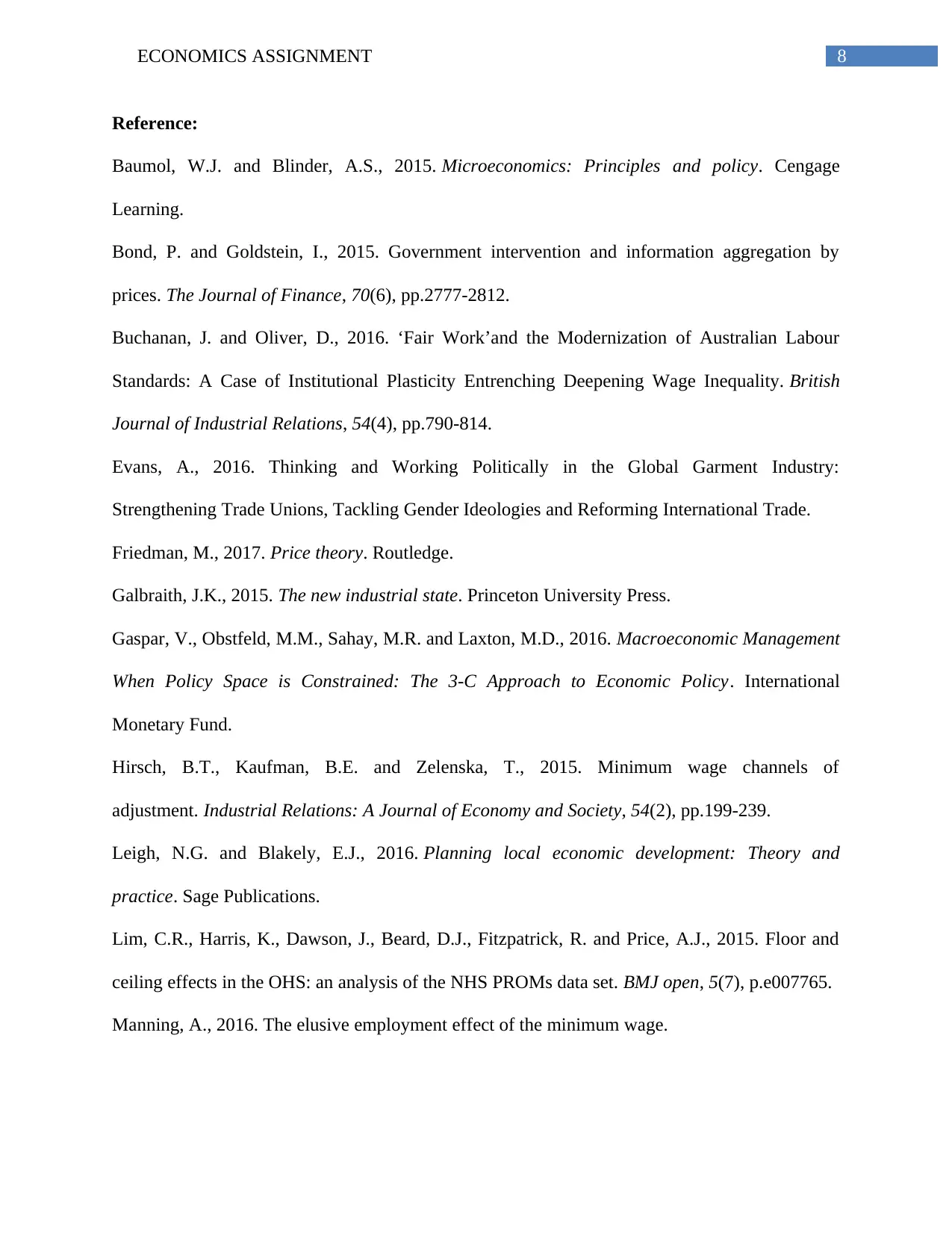
8ECONOMICS ASSIGNMENT
Reference:
Baumol, W.J. and Blinder, A.S., 2015. Microeconomics: Principles and policy. Cengage
Learning.
Bond, P. and Goldstein, I., 2015. Government intervention and information aggregation by
prices. The Journal of Finance, 70(6), pp.2777-2812.
Buchanan, J. and Oliver, D., 2016. ‘Fair Work’and the Modernization of Australian Labour
Standards: A Case of Institutional Plasticity Entrenching Deepening Wage Inequality. British
Journal of Industrial Relations, 54(4), pp.790-814.
Evans, A., 2016. Thinking and Working Politically in the Global Garment Industry:
Strengthening Trade Unions, Tackling Gender Ideologies and Reforming International Trade.
Friedman, M., 2017. Price theory. Routledge.
Galbraith, J.K., 2015. The new industrial state. Princeton University Press.
Gaspar, V., Obstfeld, M.M., Sahay, M.R. and Laxton, M.D., 2016. Macroeconomic Management
When Policy Space is Constrained: The 3-C Approach to Economic Policy. International
Monetary Fund.
Hirsch, B.T., Kaufman, B.E. and Zelenska, T., 2015. Minimum wage channels of
adjustment. Industrial Relations: A Journal of Economy and Society, 54(2), pp.199-239.
Leigh, N.G. and Blakely, E.J., 2016. Planning local economic development: Theory and
practice. Sage Publications.
Lim, C.R., Harris, K., Dawson, J., Beard, D.J., Fitzpatrick, R. and Price, A.J., 2015. Floor and
ceiling effects in the OHS: an analysis of the NHS PROMs data set. BMJ open, 5(7), p.e007765.
Manning, A., 2016. The elusive employment effect of the minimum wage.
Reference:
Baumol, W.J. and Blinder, A.S., 2015. Microeconomics: Principles and policy. Cengage
Learning.
Bond, P. and Goldstein, I., 2015. Government intervention and information aggregation by
prices. The Journal of Finance, 70(6), pp.2777-2812.
Buchanan, J. and Oliver, D., 2016. ‘Fair Work’and the Modernization of Australian Labour
Standards: A Case of Institutional Plasticity Entrenching Deepening Wage Inequality. British
Journal of Industrial Relations, 54(4), pp.790-814.
Evans, A., 2016. Thinking and Working Politically in the Global Garment Industry:
Strengthening Trade Unions, Tackling Gender Ideologies and Reforming International Trade.
Friedman, M., 2017. Price theory. Routledge.
Galbraith, J.K., 2015. The new industrial state. Princeton University Press.
Gaspar, V., Obstfeld, M.M., Sahay, M.R. and Laxton, M.D., 2016. Macroeconomic Management
When Policy Space is Constrained: The 3-C Approach to Economic Policy. International
Monetary Fund.
Hirsch, B.T., Kaufman, B.E. and Zelenska, T., 2015. Minimum wage channels of
adjustment. Industrial Relations: A Journal of Economy and Society, 54(2), pp.199-239.
Leigh, N.G. and Blakely, E.J., 2016. Planning local economic development: Theory and
practice. Sage Publications.
Lim, C.R., Harris, K., Dawson, J., Beard, D.J., Fitzpatrick, R. and Price, A.J., 2015. Floor and
ceiling effects in the OHS: an analysis of the NHS PROMs data set. BMJ open, 5(7), p.e007765.
Manning, A., 2016. The elusive employment effect of the minimum wage.
⊘ This is a preview!⊘
Do you want full access?
Subscribe today to unlock all pages.

Trusted by 1+ million students worldwide
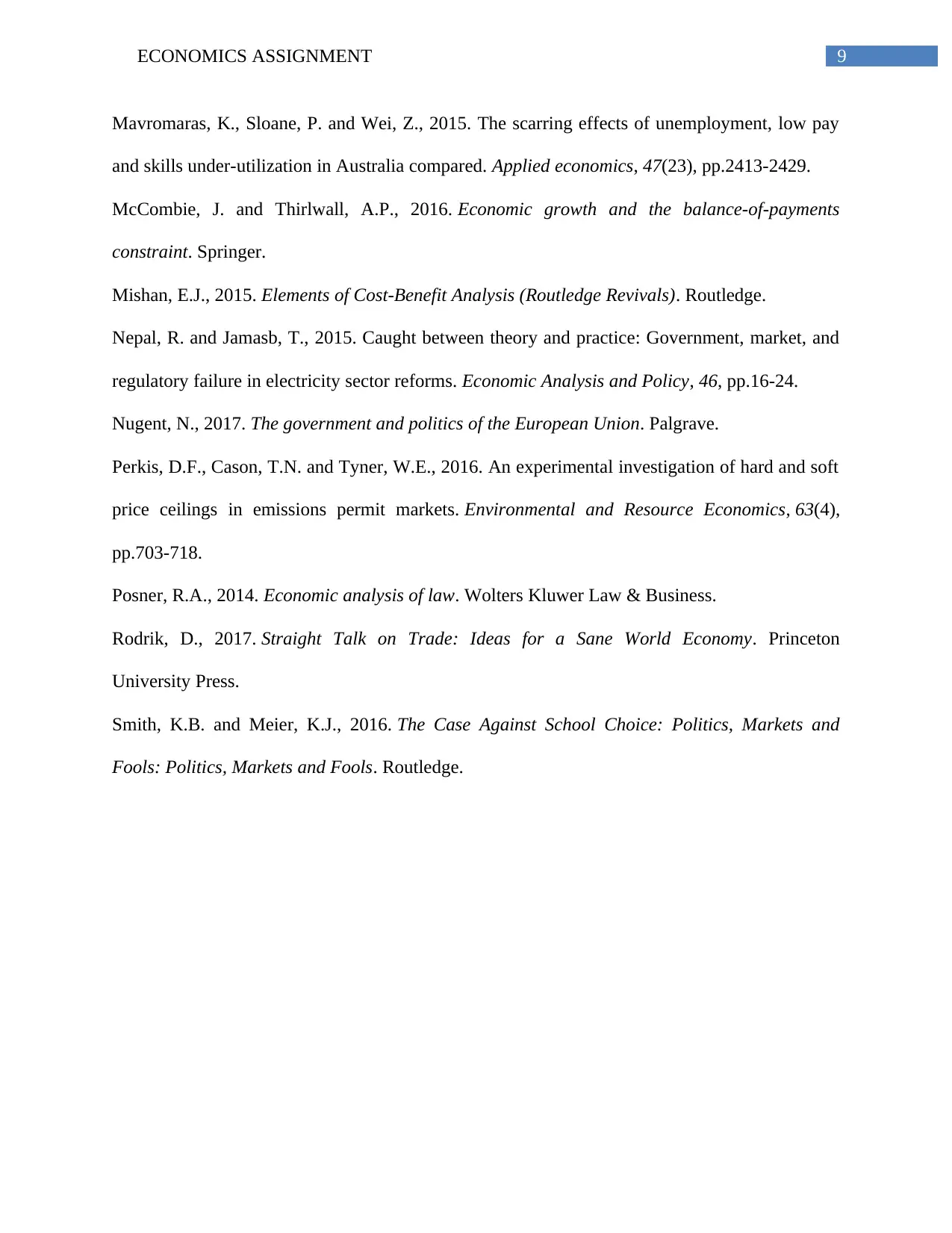
9ECONOMICS ASSIGNMENT
Mavromaras, K., Sloane, P. and Wei, Z., 2015. The scarring effects of unemployment, low pay
and skills under-utilization in Australia compared. Applied economics, 47(23), pp.2413-2429.
McCombie, J. and Thirlwall, A.P., 2016. Economic growth and the balance-of-payments
constraint. Springer.
Mishan, E.J., 2015. Elements of Cost-Benefit Analysis (Routledge Revivals). Routledge.
Nepal, R. and Jamasb, T., 2015. Caught between theory and practice: Government, market, and
regulatory failure in electricity sector reforms. Economic Analysis and Policy, 46, pp.16-24.
Nugent, N., 2017. The government and politics of the European Union. Palgrave.
Perkis, D.F., Cason, T.N. and Tyner, W.E., 2016. An experimental investigation of hard and soft
price ceilings in emissions permit markets. Environmental and Resource Economics, 63(4),
pp.703-718.
Posner, R.A., 2014. Economic analysis of law. Wolters Kluwer Law & Business.
Rodrik, D., 2017. Straight Talk on Trade: Ideas for a Sane World Economy. Princeton
University Press.
Smith, K.B. and Meier, K.J., 2016. The Case Against School Choice: Politics, Markets and
Fools: Politics, Markets and Fools. Routledge.
Mavromaras, K., Sloane, P. and Wei, Z., 2015. The scarring effects of unemployment, low pay
and skills under-utilization in Australia compared. Applied economics, 47(23), pp.2413-2429.
McCombie, J. and Thirlwall, A.P., 2016. Economic growth and the balance-of-payments
constraint. Springer.
Mishan, E.J., 2015. Elements of Cost-Benefit Analysis (Routledge Revivals). Routledge.
Nepal, R. and Jamasb, T., 2015. Caught between theory and practice: Government, market, and
regulatory failure in electricity sector reforms. Economic Analysis and Policy, 46, pp.16-24.
Nugent, N., 2017. The government and politics of the European Union. Palgrave.
Perkis, D.F., Cason, T.N. and Tyner, W.E., 2016. An experimental investigation of hard and soft
price ceilings in emissions permit markets. Environmental and Resource Economics, 63(4),
pp.703-718.
Posner, R.A., 2014. Economic analysis of law. Wolters Kluwer Law & Business.
Rodrik, D., 2017. Straight Talk on Trade: Ideas for a Sane World Economy. Princeton
University Press.
Smith, K.B. and Meier, K.J., 2016. The Case Against School Choice: Politics, Markets and
Fools: Politics, Markets and Fools. Routledge.
1 out of 10
Related Documents
Your All-in-One AI-Powered Toolkit for Academic Success.
+13062052269
info@desklib.com
Available 24*7 on WhatsApp / Email
![[object Object]](/_next/static/media/star-bottom.7253800d.svg)
Unlock your academic potential
Copyright © 2020–2025 A2Z Services. All Rights Reserved. Developed and managed by ZUCOL.




